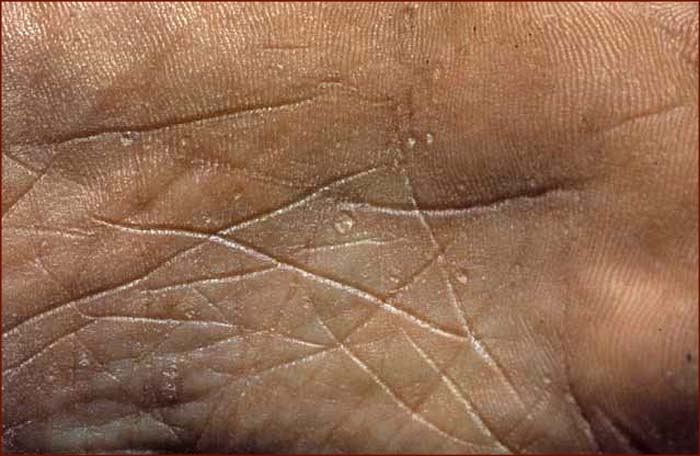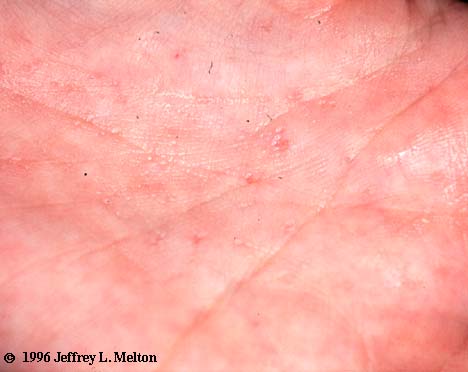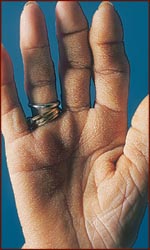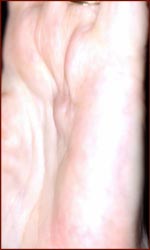|
1b - PALMAR SKIN CONDITIONS & CANCERS:
'Palmar keratosis' is more often seen in various types of cancer:
'Palmar keratosis', concerns a skin condition characterized by an overgrowth of keratin on the skin of the hand (usually papules or pits).
This skin condition in the hand is about 4 times more frequently observed in persons with cancerous tumors - compared to healthy individuals (11% to 23%).
Multiple studies have indicated that 'palmar keratosis' is often seen in patients with various type of cancers, including: bladder cancer (67% to 87%), lung cancer (71%), breast cancer, renal cancer & colon cancer.
'Palmar keratosis' (sometimes misspelled as: keritosis) is in medical science a.k.a. 'keratosis punctata palmaris et plantaris' [KPPP] which is known as a skin condition found on both the hands & feet. NOTICE: In white people the papules and pits are usually NOT found in the palmar creases.
NOTICE: 'Keratosis' is a very common (pre-cancerous growth) skin condition that can be found on various body parts in far most people.
'Keratosis pilaris' (a.k.a. 'follicular keratosis') is a very common (genetic) skin condition characterized by the appearance of small bumps usually white in color (sometimes refered as 'chicken skin') - very frequently found on body parts including: the backs of the upper arms, thighs, and (especially in women) the buttocks areas.
'Actinic keratosis' (a.k.a. 'solar keratosis' or 'senile keratosis') is the most regular type of 'skin keratosis' that is often seen on body parts of light-skinned persons that have been chronically exposed to the sun, including: the face, skull, back of the neck, tops of the forearms, and (especially in men) even the tops of the ears.
|
|
Palmar keratosis - a skin condition characterized by an overgrowth of keratin (papules or pits) on the skin of the hand:

|
|
Do not confuse the following 3 skin conditions with 'palmar keratosis'!
1 - First of all, one should NOT confuse 'palmar keratosis' with another very common and typical inner palm skin condition called: 'calluses' (the latter is usually the result of repeated pressure and friction, and can often be observed in the palmar zones below the fingers).
2 - Second, one should NOT confuse 'palmar keratosis' with a less common hand skin condition called: 'keratosis punctata of the palmar creases' (a.k.a. 'Keratosis punctata of the palmar creases' [KPPC]), which concerns the presence of pits in the hand lines - these are much more often seen in the hands of black people (1.9% to 3.1%), especially in males. But these punctata in the creases do not have an association with any type of cancer at all!

Sources:
The hand-foot syndrome!
Puzzling palmar papules and pits
Palmar keratosis in persons with cancerous tumors
Palmoplantaris keratosis: thickening of the palms AND the soles
|
|

PHOTO: Palmoplantar keratosis [PPK] is a rare variant of the relatively normal 'palmar keratosis'.
3 - Thirdly, one should NOT confuse 'palmar keratosis' with a condition called 'palmoplantar keratosis' [PPK] - see the picture on the right. 'Palmoplantar keratosis' concerns a congenital, often hereditary, thickening of the horny layer of the skin of the palms and soles, sometimes with painful lesions resulting from the formation of fissures.
|
|

